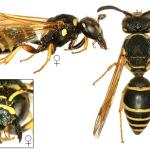The British records are all from Hampshire and Surrey, and the last record was during 1909 from the New Forest. Although the species appears to be widespread in the Channel Islands, the last record from there was made in 1957.
The species is believed to be extinct in mainland Britain (RDB1+) and is listed as Extinct in Shirt (1987) and Falk (1991). Its current status in the Channel Islands is unclear.
Mostly open heathland with bare soil; also on railway embankments.
Adults of O. reniformis have been found from late May until early August but most records are from June and July.
Cells have been found to be provisioned with lepidopterous and sawfly larvae, but also in one, a Hypera species, a weevil of the family Curculionidae (Nielsen, 1932).
Nesting areas are associated with sandy soils, being on either level ground or vertical surfaces. It has also been found nesting in the walls of a ruined cottage (Morice, 1906). The burrow entrance is about 2cm, and curved from the vertical when on level ground, or slightly down-curved when projecting from a vertical surface. The nest of O. reniformis consists of one to three cells. See Odynerus spinipes for further details of nesting biology.
Chrysis viridula has been found associated with O. reniformis in Europe.
1997


